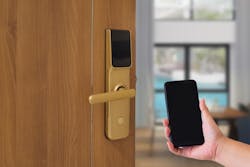Universal Access Control Puts Unmanaged Doors Within Reach
In recent years, the access control market has been the benefactor of many technological advancements. At the same time, there has been an increased demand to expand the scope of access control systems beyond just the primary building entrances and high-traffic areas to include “secondary” doors.
Perimeter locations such as garages, entry gates, elevators and doors to executive offices, supply closets and IT rooms, historically have been beyond reach for access control, typically because of the cost and installation complexities. But today’s cloud-based platforms and wireless locking technologies are putting these previously unmanageable doors within reach.
In this article, we want to look at how this can be accomplished and what security pros have to know when recommending expanded access control.
Protecting Uncommon Doors
The first step in securing so-called secondary doors is to take a look at the hardware requirements and consider the tradeoffs of hardwired solutions versus smart locks.
Entry gates -- Entry gates typically serve as a barrier to an outdoor space, such as a courtyard or a pool, without allowing access to the interior of the building. Entry gates are unique doors to secure because of their location (often outside), their use frequency (often considered high traffic) and their requirement of supporting a mix of user types, including one-time access for visitors or deliveries and primary users, such as employees or building residents.
Because they often are a distance from the main building, entry gates typically aren’t in an area that has reliable Wi-Fi signal strength to support wireless lock options. In instances where signal strength is strong enough, security pros can evaluate the anticipated traffic flow to decide whether a smart lock could support it. An area that has high traffic could exhaust the battery life of a smart lock too quickly. So, hard-wired locking hardware is recommended if the Wi-Fi signal is unreliable or the traffic flow is expected to be high.
Elevators -- Elevators are a critical point of entry to many areas of a building, so they have to have security protection like any other door on a property. The right access control solution tied to an elevator system can restrict access to specific individuals to only the necessary floors. This is an important requirement often seen in hotels, where high-floor suites are restricted to specific guests.
But it also is an important function in today’s mixed-use high-rise buildings that have shared spaces and different tenant types. Buildings, where multifamily apartment units might be located on certain floors and businesses or coworking spaces, are located on other floors require a security solution to ensure that each tenant feels safe.
Although location- and user-specific access rights might seem complex at first, good access control software manages these situations with ease. Because elevators require a constant power supply to be operational all the time, hard-wired access control hardware is the only choice for this application.
Service doors -- Storage closets, maintenance rooms and even IT rooms are spaces to which many end users would like to control access, but these locations frequently don’t make the cut because of budget constraints. Primary entrances and other perimeter doors are justifiably the higher priority for costly hard-wired solutions, but smart locks are excellent, cost-effective options for service doors.
With smart locks, customers can protect these rooms, which often contain high-value materials, while getting rid of the hassle of keys. Because service doors are almost always located inside a building, they can connect easily to the Wi-Fi network, typically have a specific set of users who should be granted access and are low-traffic doors that see openings a few times per day.
Shared-use rooms -- More frequently, commercial buildings have shared-use spaces for business tenants. Much like multifamily properties have communal pools, gyms and rooftop patios, commercial buildings now provide shared conference rooms, training facilities, huddle rooms and gyms to clients. The prevalence of this model is expected to increase in light of the trend toward remote work, which has led businesses to downsize from stand-alone office buildings to spaces where employees rotate in and out of shared workstations.
Shared-use rooms are great for smart locks because they connect with a building’s Wi-Fi easily and they typically see low to medium traffic, so battery life isn’t a major concern. The right access control system is particularly important for shared-use spaces because integration with scheduling tools that business tenants might use to book such spaces is important. Access schedules and credential management provide a seamless experience to business tenants who ultimately want to feel that the shared spaces are an extension of their own office space.
Putting It Together with Software
When adding access control to doors not typically covered by a system, selecting the hardware is only half the challenge. The lock features only come to life through the right access control software.
If a security pro installs a hard-wired access control system at primary entrances and smart locks at other doors on a site, some access management platforms require that they be managed in separate applications. This can be a real headache to those managing the day-to-day access requirements of a site.
Fortunately, today’s universal access control systems allow users to combine hardwired and smart-lock solutions into the same platform for complete management and control, which allows for future growth and a feature-rich experience for the end-user. When looking for a universal access control platform, there are four primary things that security pros should seek:
1) Cloud-Based System
Many end-users insist on remote management capabilities as the world emerges from the COVID experience. Being able to give or revoke access at a moment’s notice in light of personnel changes is critical to business continuity. Along with the necessity to provide real-time system updates, this makes having a cloud-based solution the only choice to manage today’s access control client.
2) Easy to Use
Every access control system on the market will tout ease of use as a key feature, but many don’t deliver on that promise. The software interface and application should be easy to use for anyone, security pro or end-user, who might interact with the system regularly. It should be intuitive to add or change hardware as well as manage access schedules that are critical to the daily management of a site.
3) Futureproof and Scalable
Cloud-based access control platforms are by their nature infinitely scalable. Adding wireless locks should be easy, and any system constraints only are those imposed by the limitations of the hard-wired components of a system. A universal access control platform can grow over time as the client’s system requirements change, and it can integrate and manage new hardware technology within the same platform. This is in contrast with proprietary systems that work only with select brands of hardware and can be restrictive to end-users in the long run.
4) Integration with Other Systems
Access control is not the stand-alone system it once was. Today, these systems even help to drive business processes. For instance, a company using an IT contractor might require that the access control system integrate with its ticketing software to generate access codes automatically for contractors who visit various office locations. The right universal access control platform can add value by streamlining workflows that extend beyond just managing door access on a property.
Getting Started
A little bit of advance work can go a long way in making sure that the solution you specify can meet the demands of your customers today and into the future. These checkpoints should be part of every pre-installation site audit to help you to identify the best technology options for every door.
1) Understand your users.
Make sure you understand who will interact with each door and at what frequency. That can drive decisions about the type of credentials your locks have to support. Frequent users, such as employees, might prefer prox cards or key fobs as their credentials to save time accessing the door. Temporary or less frequent users, such as delivery drivers or custodial workers, might prefer PIN codes.
2) Consider traffic areas.
Consider how frequently users might come and go through each entry point on a typical day. High-traffic areas, such as main entrances, likely aren’t suitable for smart locks because of battery-life considerations, while low-to-medium-traffic areas, such as maintenance closets or huddle rooms, are suited to wireless smart locks.
3) Check signal strength.
Wireless smart locks have to have reliable network connectivity, and network strength can vary greatly around a site. Know what’s possible in terms of connectivity to each of the doors you want to secure. For instance, it might not be possible to secure a maintenance door in a parking structure by using a wireless lock if it’s too far away from the Wi-Fi network. Making sure to examine the signal strength in advance will help to ensure the right lock is used.
4) Understand your existing system.
If access control hardware (smart or electronic locks) is on-site already, understand how it all plays into the total solution. Are the existing locks part of a system, or are they stand-alone devices? Are they cloud-based, or are they controlled by an on-premise software solution? Understanding the existing system, its infrastructure and its gaps will help you to determine how best to move, add or change it to bring total access coverage to your customers.
Also, if an access control solution already is installed, it can be useful to match the credential type on any installation to the credential type already employed. If users already use a prox card to enter a parking garage, for example, best practice would be to make sure they can use that same card to gain access to the elevator and the huddle rooms. It also can be useful to look for smart locks that provide more than one credential type. The right access control software will allow you to build on the existing system on-site and still deliver seamless credential management.
With the combination of wireless smart locks, hard-wired devices and cloud-based universal platforms available, bringing affordable access control to every door is a reality. End users recognize the necessity to eliminate keys from their entire property, from an operational perspective and because users want the simplest way to carry out daily activities. Adding access control to doors that typically aren’t included can help security pros to expand their offerings while helping end-users to save time and avoid headaches.
About the authors: Daniel Bailin is the chief product officer for RemoteLock. He’s responsible for developing and driving the technology roadmap and product innovation strategy to propel the company’s future growth. He has more than 20 years of experience in the access control, biometrics and semiconductor industries, where he has held product innovation and business development leadership roles. Kim Garcia is the director of marketing for RemoteLock. She has more than 15 years of marketing and sales experience in the security industry.
About the Author

Daniel Bailin
Director, Strategic Business Development and Innovation, HID Global
Daniel Bailin joined HID Global in 2006. He is part of the Physical Access Control business unit focusing on strategic business development and innovation and has been working with NFC, BLE and other mobile technologies since 2007. Prior to joining HID, Daniel spent 7 years in the Biometrics industry, including Authentec and Bioscrypt, in a variety of sales and business development roles. Daniel’s career began in the semiconductor industry where he held positions involving applications engineering and technical marketing. He has degrees in Chemistry and Electrical Engineering.
Kim Garcia
Kim Garcia is Director of Marketing for PSA Security Network. To request more info about PSA, visit www.securityinfowatch.com/10214742.
